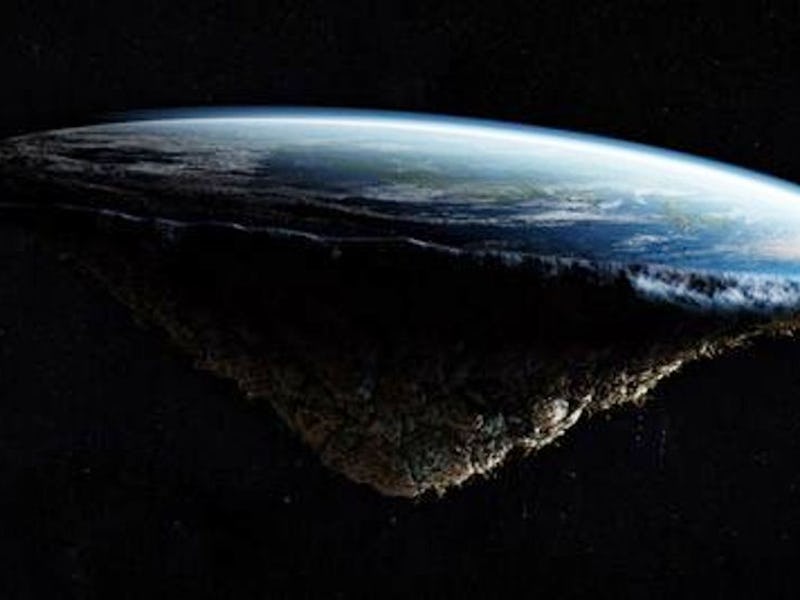Columbus Day Is D-Day for Flat-Earth Truthers
Columbus knew the Earth is round.

Charles Johnson, the late, longtime president of the Flat Earth Research Society, thought that many historical men of stature shared his belief that Earth is disk-shaped, with the North Pole at its center, and a 150 feet wall around its edge. Moses was a flat-earther, he argued, and George Washington was one, too. Christopher Columbus was obviously a flat-earther, Johnson said in a 1980 interview, and it was that belief that helped him keep his cool as he sailed to the Americas.
“There was a dispute on the ship, but it was because Columbus was a flat-earther,” said Johnson, who died in 2001. “The others believed the Earth to be a ball, and they just knew that they were falling over the edge and couldn’t get back.
“Columbus had to put them in irons and beat them until he convinced them they weren’t going over any curve, and they could return.”
On Columbus Day, it’s important to remember Johnson was very wrong, on multiple levels. There’s no evidence that Columbus thought the world was flat, and piles of facts that point to the idea that it would be pretty insane if he did.
Secondly, it’s also true that the big reveal of Columbus’ voyage wasn’t that the world was round — pretty much the whole world agreed at that time that it was already. Most educated people in the time of Columbus knew the Earth was round. As the Washington Post reported in 2011, “several books published in Europe between 1200 and 1500 discussed the Earth’s shape, including The Sphere, written in the early 1200s, which was required reading in European universities in the 1300s and beyond. It was still in use 500 years after it was penned.”
How Flat-Earthers think the planet looks.
People began to be aware that the Earth was round as early as the sixth century — that’s when the Greek mathematician Pythagoras first argued that the Earth was a sphere. Astronomer and mathematician, Ptolemy followed up this idea in his Geography, and the aformentioned geography book, The Sphere, became required reading in European universities in the 1300s. Columbus even owned an edition of Geography.
“It must be reiterated that with extraordinary few exceptions no educated person in the history of Western Civilization from the third century B.C. onward believed that the Earth was flat,” historian Jeffrey Russel said a 1997 speech at the American Scientific Affiliation Conference. “On the other side tens of thousands of Christian theologians, poets, artists, and scientists took the spherical view throughout the early, medieval, and modern church … No one before the 1830s believed that medieval people thought that Earth was flat.”
From Whence the the Columbus/Flat-Earth Myth Came
If it was widely accepted that the world was round, how did history get written so Columbus became a flat-earth truther? Historians think it comes down to two men: A 1800s French academic named Antoine-Jean Letronne and legendary American writer Washington Irving. Letronne wrote that Columbus proved the world was round as a way to make religious people look dumb, or as Russell puts it, took it as an opportunity to “misrepresent the church fathers and their medieval successors as believing in a flat Earth.” Irving, for his part, just straight up lied to make his stories about Columbus better: His “biography” of the dirtbag, A History of the Life and Voyages of Christopher Columbus, turned the man into a myth through embellishments.
The idea that Columbus was astonished to find the Earth wasn’t flat took off after this book was published in 1828, and countless people have believed that lie ever since.
The Flat Earth Society was founded in 1884, and thousands of people still think the Earth is flat in the year of our Lord 2017.
Flat-earthers today don’t believe the photographic evidence we have that the Earth is round, and don’t accept explanations of the Earth’s oblate spheroid shape that include, but are not limited to, the facts that different constellations can be seen in different regions of the world, that the sun’s movement reveals the Earth’s curvature, and that the Earth’s roundish shadow can be seen on the Moon.
There’s no evidence to back up that claim, yet flat-earthers are resolute in their beliefs. That’s a bummer for the progress of scientific thought.
If you liked this article, check out this video on how the Flat Earth movement is making a comeback.